
9 minute read
LITERATURE REVIEW
LITERATURE REVIEW
BOOK REVIEW
Advertisement
A Review of Sustainable Landscaping: Principles and Practices
Article in Journal of Agricultural & Food Information · October 2015 -This article includes review of book sustainable landscaping: principles and practices by Marietta Loehrlein .This title provides a thorough overview of landscaping with sustainability as the emphasis. The first chapter of book sets the context, defining sustainability, giving a short history of the sustainability movement, and mentioning key scholars as well as first principles; as with medicine, the core concept is “do no harm”; second principle is conservation, reservation and regeneration. Also, there is information about soil, carbon, fertilization and building up organic matter creating and using compost phytoremediation , use of and precautions with pesticides and the like. Also, there are Tables of beneficial and invasive trees, flowers and shrubs, and several lists of native species for specific purposes, such as attracting butterflies, are a useful inclusion also there is one chapter which includes the water conservation and brief case studies from Colorado, Arizona, and California and the use of gray water for irrigation; students of architecture and horticulture can use this book as textbook as this book language is not highly technical and most of the terms are defined.
Article: review 1
What do we mean by sustainable landscape?
Dimensions of sustainable landscape: environment, economics, society, governance, sustainable development is generally considered to at intersection of environment economy and society, although these terms are now often expanded into phrases reflecting eco system services and limits.
Many authors also draw attention to fourth dimension of political sustainability referring tom the governance's mechanisms that continuously deliver sustainable development through the use of responsible science and economics. the millennium ecosystem assessment (2005) has popularized the notion of ecosystem services underpinning human wellbeing notably provisioning services such as flood, water, timber and fiber. regulating services that affect climate, floods, disease, waste and water quality supporting services such as formation, photosynthesis and nutrient cycling.
Article: review 2
Importance of humane design for sustainable landscape
sustainable landscape? -sustainable landscape architecture is architecture that seeks to minimize the negative environmental impact of buildings by efficiency and moderation in the use of materials, energy, development spaces.
hierarchy of sustainability

sustainable landscape architecture is category of sustainable design concerned with planning and design of outdoor space, this can include social economic and ecological aspects of sustainability.
sustainable city: includes sustainable decision making, sustainable society, sustainable economy, sustainable environment.
Humane design for creation sustainable landscape.
Human design
Sustainable environment
Sustainable economy life cycle natural resources
Research paper 1- Review
Theories methods and strategies for sustainable landscape planning
This paper discusses about theory methods and challenges to sustainable landscape planning. The four principle sectors of planning: 1) Physical / spatial 2) policy 3) social and economic the objective of this paper is to review briefly the theory of contemporary sustainable planning, to present a typology of landscape planning methods and apply the typology to several landscape planning methods
Typology to classify sustainable landscape planning methods for operational purpose it is useful to organize number of approaches framework and methods that are currently available. The following typology is offered on basis for this organization: it includes fire subcategories 1) Theoretical orientation: there are two fundamental types of theory in landscape planning: sustentive and procedural. 2) resource or goal orientation 3) in disciplinary and transdisciplinary4) strategic orientation 5) spatial concepts.
Selected landscape planning methods: three planning methods are briefly discussed 1) ecological planning method.
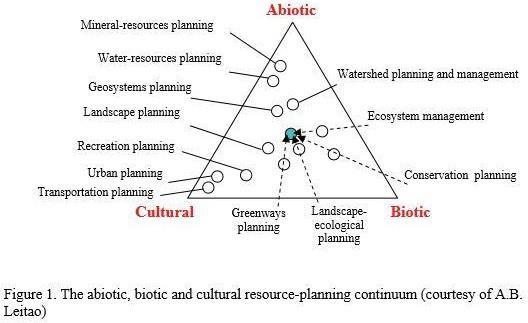
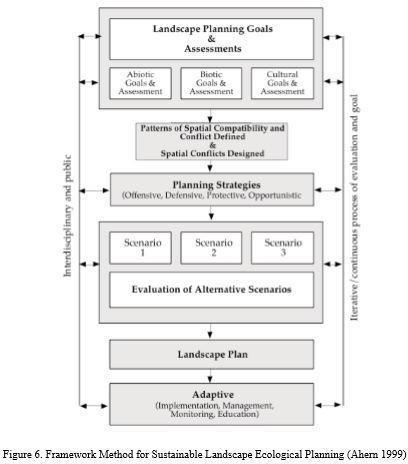
Research paper 2- Review
Sustainable landscape architecture
Implications of the Chinese philosophy “unity of man with nature” and beyond Abstract: as the world population continues to grow and as global organization continues to unfold our ecosystem and landscape will be increasingly domesticated and designed. In this paper there is argue about “unity of man with nature “(Chinese philosophy) and its associated design principles can provide useful guidelines for this integration as well as development of sustainable landscape practices.
traditions and perspective of Chinese landscape architecture. The ‘‘unity of man with nature’’ philosophy-The ideals and practices of Chinese landscape architecture have been profoundly influenced by ancient Chinese philosophies and cultural traditions. The unifying theme of ancient Chinese philosophies and cultural traditions is ‘‘unity of man with nature’’ or ‘‘harmony between man and nature’’. This theme is consistent with the central tenet of Taoism, a celebrated Chinese philosophy developed by Lao Zi, which asserts that humans should harmonize with the rhythms of nature.
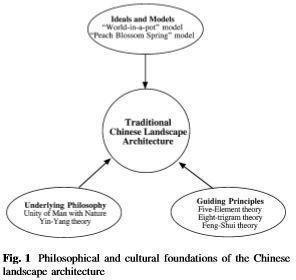
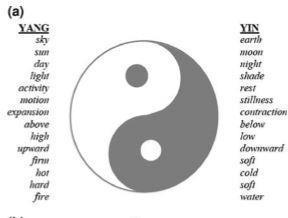
Yin- yang theory –the fire element guided by the yin yang principle, claims that the material world composed of fire kinds of elements (metal, wood, water, fire and earth) all are related to each other by either a creating –being created relationship 2) framework method for sustainable landscape ecological planning. Feng–shui theory- Feng–Shui theory, or the theory of Feng (wind) and Shui (water), consists of a set of empirical principles that integrate biophysical landscape features with cultural traditions and religious beliefs to guide the practice of selecting and designing dwelling and burial spaces. Feng–Shui theory stems from the
Taoist Yin–Yang dualism, the Five Element theory and the Eight-Trigram theory. Yin–Yang dualism is the conceptual basis for both the Five Element and Eight-Trigrams theory. Yin– Yang dualism emphasizes balancing opposing natural, as well as anthropogenic, forces and organizing evolving parts to achieve the harmony and eternity of the whole. The Five-Element theory further articulates how the five essential elements comprising the world are related to each other and how they can be arranged properly to achieve sustainability. Related to the Five-Element theory is the theory of Eight Trigrams, which deals with more components that make up the world and has been commonly used as a tool in Feng–Shui practice
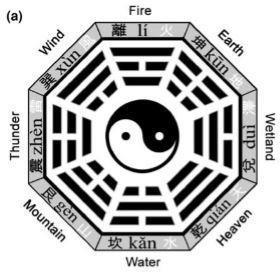
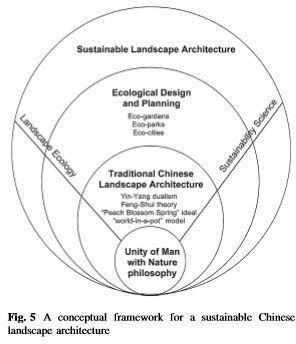
Document review 1- The sustainable site initiative (American society of landscape architects)
This document provides background on the sustainable site initiative a set of augments, economic, environmental and social for the adoption of sustainable landscape practices this document includes information about 1) purpose and principles of sustainable site initiative 2) the economics of sustainable landscape 3) an introduction to ecosystem services 4) case studies
Purpose and principles: socially equitable, environmentally sound, economically feasible are 3 components of sustainability the primary focus for the sustainable site initiative is the environment including those aspects of economic feasibility and social equity that intersect with environment. The benefits of sustainable practices: The elements in a functioning ecosystem are so highly interconnected that unsustainable approaches to land development and management practices can have a devastating ripple effect throughout the system. The following examples of sustainable approaches demonstrate how thoughtful design, construction, operations, and maintenance can enhance and restore ecosystem services that would otherwise be lost.
Valuing soils: the undervaluation of soils is one of the most significant failings of the conventional development approach. For example, a frequent consequence of standard construction practices is compaction of the soil, which seriously damages soil structure by shrinking the spaces between soil particles available for air and water. If not restored, compacted soil can start a spiral of degradation.
Damage to vegetation: Compacted soil particles restrict a plant’s root growth and its access to nutrients. If soil compaction continues, vegetation eventually dies and soils become vulnerable to erosion.
Reduced infiltration: Compacted soils are less able to absorb water, which reduces the recharge of groundwater and aquifers.
Excess runoff: Reduced infiltration leads to increases in the volume of runoff and the probability of flooding. On developed sites where there is widespread use of impervious material such as concrete and asphalt, even more runoff is likely.

Runoff curve numbers for different site types. The runoff curve number is product of empirical data from many depressions, and infiltrated. Any rainfall not retained on site becomes runoff. All sites in illustration above are assumed to have similar slopes and similar soils. However, as development increases from woods to row crop agriculture to residential and urban landscape - so does soil compaction and increasing amounts of impervious area result in less water retained on site and more of it running off, thus raising a sites curve number. A Higher curve number, it run corresponds to a greater predicted runoff volume.
Treating water as resource –wasteful irrigation
undervaluing rain: Rather than getting rid of storm water runoff as quickly as possible, a sustainable approach to storm water management would find ways to capture it on site and use it for irrigation, ornamental water features, drinking water, and groundwater recharge.
The waste hierarchy:
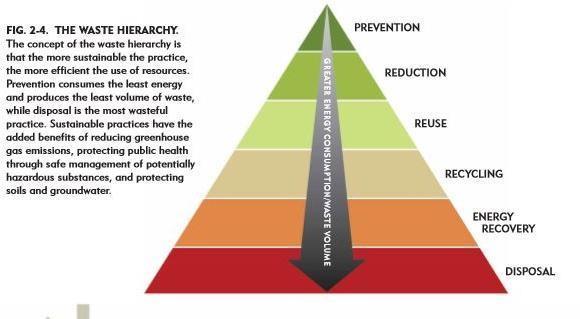
The bounty of ecosystem. No one type of ecosystems has a monopoly on the goods and services it can provide, and the services listed here represent only a few of the many services available from each type. With sustainable practices, built landscapes can provide many of these same natural services. Illustration adapted from the Milennium ecosystem assessment.
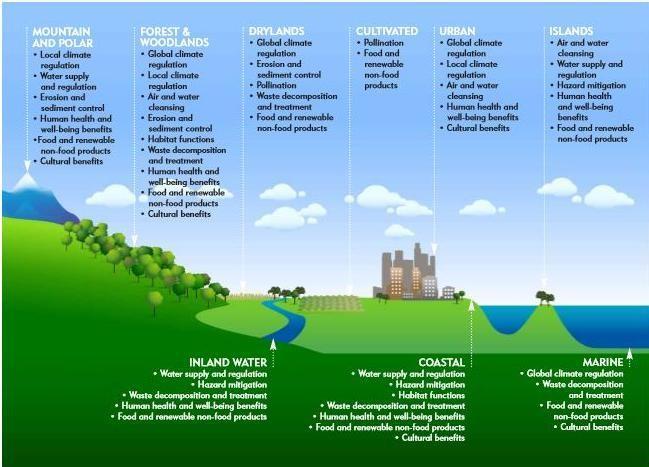
Document review 2- Guidance for Federal Agencies on Sustainable Practices for Designed Landscapes
This document includes nice sections based on process of site development agencies are strongly encouraged to develop sustainable landscape plan that encompasses following elements: site selection and planning, soils water vegetation, materials selection human health and wellbeing and exiting / historic facilities and cultural landscapes constrictions, operations and managements.
Background -The best practices and performance goals for the design, construction, and maintenance of sustainable landscapes described in this document were drawn from Federal agency subject matter experts and from the 2009 Sustainable Sites Initiative or (SITES™). The following principles served as a foundation for the recommendations in this guidance.
Do no harm: Avoid changes to the site that will degrade the natural environment and promote reuse and improvement of sites with previous disturbance or development.
Precautionary principle: Do not create risk to human and environmental health. Examine a full range of alternatives—including no action.
Design with nature and culture: Create and implement designs that are responsive to economic, environmental, and cultural conditions at local and regional levels.
Use a decision-making hierarchy of preservation, conservation, and regeneration: Maximize and mimic the benefits of ecosystem services by preserving existing environmental features, conserving resources in a sustainable manner, and regenerating lost or damaged ecosystem services.
Use a system thinking approach: Understand and value the relationships in an ecosystem and sustain ecosystem services; strive to re-establish the integral and essential relationship between regenerative systems (natural processes) and human activity.
Provide regenerative systems: Provide future generations with a sustainable environment supported by regenerative systems and resources. Also, this document includes nine sections based on the process of site development and guide an integrated team through the project phases. Agencies are strongly encouraged to develop and maintain a comprehensive sustainable landscape plan that encompasses the following elements.




